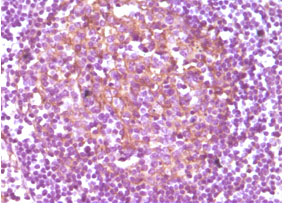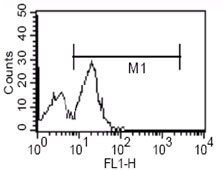CD14 Monoclonal Antibody
- Catalog No.:YM0103
- Applications:IHC;IF;FCM;ELISA
- Reactivity:Human
- Target:
- CD14
- Fields:
- >>MAPK signaling pathway;>>NF-kappa B signaling pathway;>>Phagosome;>>Toll-like receptor signaling pathway;>>Hematopoietic cell lineage;>>Alcoholic liver disease;>>Shigellosis;>>Salmonella infection;>>Pertussis;>>Legionellosis;>>Amoebiasis;>>Tuberculosis;>>Transcriptional misregulation in cancer;>>Acute myeloid leukemia;>>Lipid and atherosclerosis
- Gene Name:
- CD14
- Protein Name:
- Monocyte differentiation antigen CD14
- Human Gene Id:
- 929
- Human Swiss Prot No:
- P08571
- Mouse Swiss Prot No:
- P10810
- Immunogen:
- Purified recombinant fragment of human CD14 expressed in E. Coli.
- Specificity:
- CD14 Monoclonal Antibody detects endogenous levels of CD14 protein.
- Formulation:
- Liquid in PBS containing 50% glycerol, 0.5% BSA and 0.02% sodium azide.
- Source:
- Monoclonal, Mouse
- Dilution:
- IHC 1:200 - 1:1000. Flow cytometry: 1:200 - 1:400. ELISA: 1:10000.. IF 1:50-200
- Purification:
- Affinity purification
- Concentration:
- 1 mg/ml
- Storage Stability:
- -15°C to -25°C/1 year(Do not lower than -25°C)
- Other Name:
- CD14;Monocyte differentiation antigen CD14;Myeloid cell-specific leucine-rich glycoprotein;CD antigen CD14
- References:
- 1. J Mammary Gland Biol Neoplasia 2000, 5 : 227-241.
2. J Mammary Gland Biol Neoplasia 2000, 5 : 165-185.
- Background:
- The protein encoded by this gene is a surface antigen that is preferentially expressed on monocytes/macrophages. It cooperates with other proteins to mediate the innate immune response to bacterial lipopolysaccharide. Alternative splicing results in multiple transcript variants encoding the same protein. [provided by RefSeq, Mar 2010],
- Function:
- function:Cooperates with MD-2 and TLR4 to mediate the innate immune response to bacterial lipopolysaccharide (LPS). Acts via MyD88, TIRAP and TRAF6, leading to NF-kappa-B activation, cytokine secretion and the inflammatory response. Up-regulates cell surface molecules, including adhesion molecules.,online information:CD14 entry,similarity:Contains 11 LRR (leucine-rich) repeats.,subunit:Belongs to the lipopolysaccharide (LPS) receptor, a multi-protein complex containing at least CD14, MD-2 and TLR4.,tissue specificity:Expressed strongly on the surface of monocytes and weakly on the surface of granulocytes; also expressed by most tissue macrophages.,
- Subcellular Location:
- Cell membrane ; Lipid-anchor, GPI-anchor . Secreted . Membrane raft . Golgi apparatus . Secreted forms may arise by cleavage of the GPI anchor. .
- Expression:
- Detected on macrophages (at protein level) (PubMed:1698311). Expressed strongly on the surface of monocytes and weakly on the surface of granulocytes; also expressed by most tissue macrophages.
- June 19-2018
- WESTERN IMMUNOBLOTTING PROTOCOL
- June 19-2018
- IMMUNOHISTOCHEMISTRY-PARAFFIN PROTOCOL
- June 19-2018
- IMMUNOFLUORESCENCE PROTOCOL
- September 08-2020
- FLOW-CYTOMEYRT-PROTOCOL
- May 20-2022
- Cell-Based ELISA│解您多样本WB检测之困扰
- July 13-2018
- CELL-BASED-ELISA-PROTOCOL-FOR-ACETYL-PROTEIN
- July 13-2018
- CELL-BASED-ELISA-PROTOCOL-FOR-PHOSPHO-PROTEIN
- July 13-2018
- Antibody-FAQs
- Products Images

- Immunohistochemistry analysis of paraffin-embedded human lymphnode, showing membrane localization with DAB staining using CD14 Monoclonal Antibody.

- Flow cytometric analysis of human PBMC using CD14 Monoclonal Antibody.



